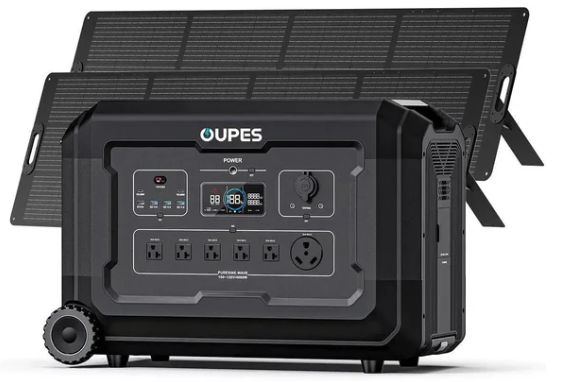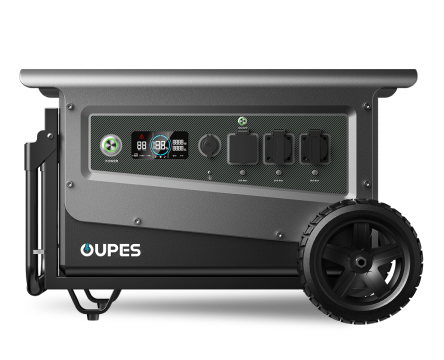
Table of Contents
- What Is a Solar Charge Controller?
- Why Are Charge Controllers Important?
- PWM vs. MPPT: An Overview
- Key Technical Differences
- Efficiency and Real-World Performance
- Cost and Usage Considerations
- Which Controller Should You Choose?
- Solar Generators and MPPT Controllers
- FAQ
What Is a Solar Charge Controller?
A solar charge controller is a device that regulates the flow of electricity from solar panels to batteries. Its main role is to prevent battery overcharging and to control the voltage output, ensuring your solar system runs efficiently and safely. Without one, batteries could be damaged by inconsistent power flow or excess voltage.
In modern solar systems — including portable solar setups and home battery banks — two types of controllers are common: PWM (Pulse Width Modulation) and MPPT (Maximum Power Point Tracking). Understanding the differences between them helps you select the best fit for your system.
Why Are Charge Controllers Important?
1. Battery Protection
A controller protects the battery from being overcharged or deeply discharged. It ensures the charging process remains stable, which prolongs battery life.
2. Voltage Regulation
Different solar panels output varying voltage levels depending on sunlight. Charge controllers balance this voltage so that your batteries receive safe and usable power.
3. Reverse Current Prevention
At night, energy can flow backward from batteries to panels. Charge controllers prevent this, protecting your system from unnecessary power loss.
PWM vs. MPPT: An Overview
What Is PWM (Pulse Width Modulation)?
PWM charge controllers connect the solar array directly to the battery, gradually reducing charging current as the battery reaches full capacity. They are simple, reliable, and cost-effective, but they do not extract the maximum available power from solar panels.
What Is MPPT (Maximum Power Point Tracking)?
MPPT controllers use a smart tracking algorithm to find the optimal balance between voltage and current — the point where the panel produces the most power. They can convert excess voltage into additional current, increasing charging efficiency by up to 30%. Data from the National Renewable Energy Laboratory (NREL) confirms that MPPT systems perform better under changing light or temperature conditions.
Key Technical Differences
| Aspect | PWM Controller | MPPT Controller |
|---|---|---|
| Operating Method | Directly connects panels to battery | Tracks and converts power at the panel’s maximum point |
| Efficiency Rate | ~75–85% | ~95–99% |
| Best System Size | Small (under 200W) | Medium to large (200W+) |
| Voltage Matching | Panel and battery must match voltage | Allows higher panel voltage than battery voltage |
| Cost | Low | Moderate to high |
| Ideal Environment | Hot and sunny regions | Variable or cold climates |
Efficiency and Real-World Performance
1. Energy Conversion
MPPT controllers use advanced electronics to convert higher panel voltage into usable battery current. PWM units, by contrast, lose efficiency when the panel voltage is higher than the battery voltage. This makes MPPT particularly effective during cool mornings or cloudy days.
2. Practical Example
Suppose a 300W panel outputs 18V and is charging a 12V battery. A PWM controller can only deliver roughly 200W of usable power, as it reduces the panel voltage to match the battery. An MPPT controller converts the extra voltage into more current, allowing around 270–290W to reach the battery — a 30–40% gain.
3. Adaptability in Real Environments
MPPT controllers automatically adjust charging parameters as sunlight changes throughout the day. They’re also better suited for portable solar setups or systems with panels wired in series — such as solar generators made by OUPES.
Cost and Usage Considerations
1. Budget vs. Efficiency
PWM controllers are affordable and easy to use, making them ideal for small-scale or budget-conscious users. MPPT units cost more but offer faster charging, higher conversion rates, and better long-term value.
2. System Complexity
PWM controllers are plug-and-play, suitable for beginners. MPPT models require more setup but deliver superior performance, especially in off-grid or high-capacity systems.
3. Durability and Lifespan
Both types are durable, but MPPT controllers include advanced protections such as temperature compensation and overload protection, extending the overall system lifespan.
Which Controller Should You Choose?
Choose PWM If:
- You’re building a small DIY solar system (below 200W).
- Your budget is limited and simplicity is key.
- You live in an area with consistent, strong sunlight.
Choose MPPT If:
- Your solar system is over 200W or uses multiple panels.
- You experience cloudy, cold, or variable sunlight conditions.
- You want the fastest possible charging for your portable power station.
Solar Generators and MPPT Controllers
1. Integrated Efficiency
Most modern solar generators now come with built-in MPPT charge controllers. This design optimizes power harvesting directly from solar panels, making them efficient and user-friendly.
2. OUPES Example
OUPES portable solar generators use MPPT technology to achieve faster charging and improved reliability. They are ideal for off-grid living, home backup, and outdoor activities — offering quiet, clean energy without fuel dependence.
3. Environmental Impact
Using an MPPT-equipped solar generator helps reduce carbon emissions and dependence on fossil fuels. According to the International Energy Agency (IEA), renewable technologies like solar can lower household emissions by up to 1.5 tons annually.
FAQ
1. Is MPPT always better than PWM?
Not necessarily. MPPT provides better efficiency and flexibility, but for low-power or budget-friendly systems, PWM remains sufficient.
2. Can I mix PWM and MPPT controllers in one system?
It’s possible but not recommended, as the two types regulate voltage differently and can interfere with each other’s performance.
3. Do solar generators need external charge controllers?
No. Most quality solar generators — like those from OUPES — already include built-in MPPT controllers.
4. How much energy can MPPT save compared to PWM?
Under optimal conditions, MPPT can improve efficiency by 25–40%, particularly when solar panel voltage is higher than battery voltage.
5. Which type is better for cold climates?
MPPT performs far better in cold weather because solar panels produce higher voltage, which the controller efficiently converts into additional current.
Conclusion
Choosing between a PWM and MPPT solar charge controller depends on your power needs and setup size. PWM controllers are reliable and inexpensive, suitable for smaller systems with consistent sunlight. However, MPPT controllers deliver higher efficiency, better energy yield, and are ideal for advanced or variable-condition solar systems. For those using portable solar generators, like the ones by OUPES, integrated MPPT technology ensures faster charging, greater power stability, and long-term reliability — helping you get the most from your solar investment.




























